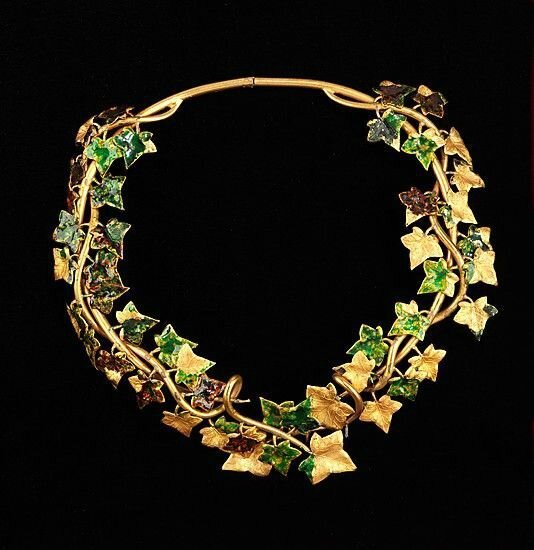Elsa Schiaparelli, (Italian, 1890–1973). Necklace, 1938


Elsa Schiaparelli, (Italian, 1890–1973). Necklace, 1938. The Metropolitan Museum of Art, New York. Brooklyn Museum Costume Collection at The Metropolitan Museum of Art, Gift of the Brooklyn Museum, 2009; Gift of Arturo and Paul Peralta-Ramos, 1955 (2009.300.1236) © 2000–2016 The Metropolitan Museum of Art.
The symbolism connected to the ivy plant is varied. Based on its evergreen nature, and the ability to grow in the darkest of places despite lack of light, it has been seen as a symbol of fidelity and enduring friendship. In pagan cultures and religious rites, ivy symbolized growth, determination and death, as it had the strength to kill larger plants and in Roman times, it was a symbol of the god of wine Bacchus. Most likely, Schiaparelli took inspiration from Botticelli's painting "Primavera," in particular his personification of the season in the goddess of spring Flora. In the painting, Flora is wearing a gown covered with various types of flowers and a garland that includes ivy. The nymph Chloris (who later becomes Flora) spews flowers and plants from her mouth, including ivy leaves. Schiaparelli’s interpretation of these ancient ideas and Renaissance paintings are seen throughout the fall 1938 pagan collection, ripe with references from Botticelli's lush depictions. One such example is this necklace, worn by the stylish Millicent Rogers. It is a one-of-a-kind work that was crafted with a true sense of realism, particularly in the sinuous twining of the ivy branches, like a growing vine, the detailed inclusion of veins and the variations in curvature of the leaves.

/https%3A%2F%2Fprofilepics.canalblog.com%2Fprofilepics%2F1%2F0%2F100183.jpg)
/https%3A%2F%2Fstorage.canalblog.com%2F03%2F02%2F119589%2F96711876_o.jpg)
/https%3A%2F%2Fstorage.canalblog.com%2F11%2F31%2F119589%2F94773502_o.jpg)
/https%3A%2F%2Fstorage.canalblog.com%2F20%2F83%2F119589%2F94772815_o.jpg)
/https%3A%2F%2Fstorage.canalblog.com%2F26%2F72%2F119589%2F75604929_o.jpg)
/https%3A%2F%2Fstorage.canalblog.com%2F59%2F60%2F119589%2F26458628_o.jpg)


/http%3A%2F%2Fstorage.canalblog.com%2F06%2F39%2F119589%2F129007933_o.jpg)
/http%3A%2F%2Fstorage.canalblog.com%2F44%2F83%2F119589%2F127871620_o.jpg)
/http%3A%2F%2Fstorage.canalblog.com%2F12%2F22%2F119589%2F127871571_o.jpg)
/http%3A%2F%2Fstorage.canalblog.com%2F95%2F78%2F119589%2F112065126_o.jpg)